Gunungan (wayang)
The gunungan (Javanese "mountain"), also known as kayon or kayonan (from kayu, "wood" or "tree") in Bali, is a figure in the Indonesian theatrical performance of wayang e.g. wayang kulit, wayang klitik, and wayang golek.
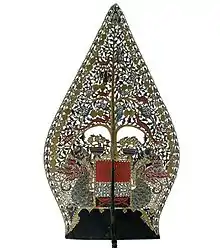
a Javanese gunungan with closed porch and two large yakshas on the sides. The roots of the tree rise into the water. There are some animals in the tree crown, but the demon head (kala) is missing.
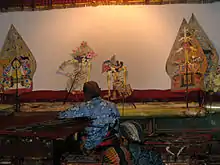
The gunungan in this wayang performance in Yogyakarta served as props.
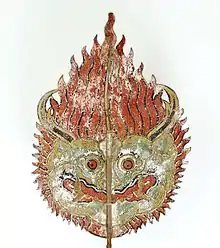
The figure of Api ("fire"), a Balinese fire demon, which has a similar form with the kayonan.
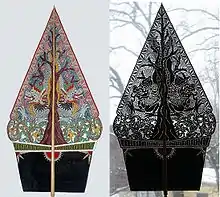
A gunungan from a variation of wayang kulit of Lombok, with which the story of Serat Menak Sasak is told.

A wayang beber at the Mangkunegaran Palace in Surakarta. Typical combat scene, gunungan slightly to the right of the center.
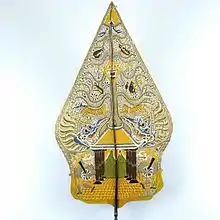
A typical Javanese gunungan with a depiction of entrance in the center and a Kala head in the upper-center image.
See also
Cited works
- Harnish, David (2003). "Worlds of Wayang Sasak: Music, Performance, and Negotiations of Religion and Modernity". Asian Music. Köln. 34 (2).
- Kant-Achilles, Mally; Seltmann, Friedrich; Schumacher, Rüdiger (1990). Wayang Beber. Das wiederentdeckte Bildrollen-Drama Zentral-Javas [Wayang Beber. The rediscovered scroll-drama of Central Java] (in German). Stuttgart: Franz Steiner.
- Spitzing, Günter (1981). Das indonesische Schattenspiel. Bali – Java – Lombok [The Indonesian Shadowplay. Bali - Java - Lombok] (in German). Köln: DuMont.
| Wikimedia Commons has media related to Gunungan (wayang). |
This article is issued from Wikipedia. The text is licensed under Creative Commons - Attribution - Sharealike. Additional terms may apply for the media files.